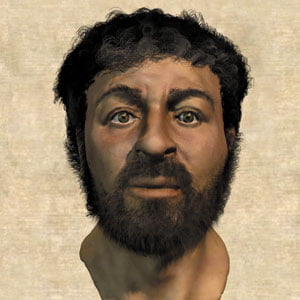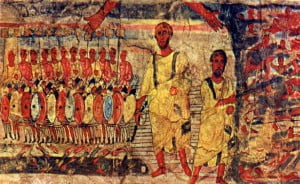What did Jesus look like?
 At that place's a subject area which anybody is talking about, and which threatens to dissever the church. Jesus does not mention it explicitly, simply he does non contradict the articulate references that we find in the Old Attestation. Some would argue that it is a question of indifference, ofadiaphora, where others point to the consequences of going against the implicit assumptions of the Bible as undermining Scripture's say-so in the contemporary church. They say that the just reason Christians are now irresolute their view is because of changes in culture, and we in danger of simply conforming to the world around us. This pressing question, is of course, whether men should be clean shaven.
At that place's a subject area which anybody is talking about, and which threatens to dissever the church. Jesus does not mention it explicitly, simply he does non contradict the articulate references that we find in the Old Attestation. Some would argue that it is a question of indifference, ofadiaphora, where others point to the consequences of going against the implicit assumptions of the Bible as undermining Scripture's say-so in the contemporary church. They say that the just reason Christians are now irresolute their view is because of changes in culture, and we in danger of simply conforming to the world around us. This pressing question, is of course, whether men should be clean shaven.
(Sorry, I couldn't resist that!) Terminal twelvemonth I wrote on the question of whether Jesus had a bristles, and noted that, in early iconography, Jesus was often beardless until around the sixth century. This was because images of Jesus aimed non to reproduce his likeness, but to limited his significance within civilization. So if Jesus was depicted as an all-powerful deity, he might look like Zeus; if he was a wise instructor, he might exist made to announced like a philosopher. Fashions inverse, and when wise men were mostly depicted as disguised, then was Jesus. (In that location is some theological significance to this, to which we shall return).
There are several reasons why I think Jesus did not accept a beard. Start, beards are mentioned in the Old Attestation quite frequently, merely non at all in the New Testament. (In other first century accounts, such every bit Josephus, no mention is fabricated of Jews having beards.) In particular, the 'servant' in Is l.6 has his bristles pulled, and this account appears to have shaped the accounts of Jesus' trial and mocking—and nonetheless without mention of anyone pulling his beard. If he had had a beard, information technology would have been pulled, and if information technology had been, there is no doubt the gospel writers would take mentioned it.
Last month, I came across a great article past Joan Taylor, Professor of Christian Origins and 2d Temple Judaism at King's College London. It was published inThe Ancient Near Eastward Today, the journal of the American Schools of Oriental Inquiry, and is available online on their weblog. (You lot need to annals to read the whole article, but it is free and involves no commitment.) Joan as well notes the fashion that iconography of Jesus was determined by his significance, non by any sense of concrete likeness. On the question of beards, she thinks he might have been disguised for practical reasons (as he was itinerant) or to follow the habit of philosophers, just she makes these important observations:
He did not have a beard just because he was Jew. A bristles was not distinctive of Jews in antiquity. While by the time the Babylonian Talmud was written in the fifth-6th centuries beardedness might take been mutual for Jewish men (b.Shabbat 152a, 'The glory of a face is its beard'), information technology was never identified as an indicator of Jews in the 1st century. In fact, one of the problems for oppressors of Jews in the Diaspora was identifying them when they looked like everyone else. However, the Jewish men onJudaea Capta coins (issued past Rome later on the capture of Jerusalem in 70 CE) are bearded only with short hair; this is probably how Romans imagined Jewish men in Judaea, even if in the Diaspora a Jewish man may have looked like every other guy.
 Taylor and so goes on to discuss other aspects of Jesus' appearance. The first thing to notation is that Jesus' wear was, unlike John the Baptist'southward, unremarkable, as few comments are fabricated most it in the gospels. In dissimilarity to contemporary depictions in film, Jesus would likely have worn a brusk, knee-length undergarment (thechiton, unremarkably translated 'shirt'; see e.g. Matt 5.40, Luke iii.xi, John nineteen.23). Long habiliment was 'girly or godly', either worn by women or the wealthy who did not have to piece of work. This garment would invariably have had ii band of color, running from the shoulder to the hem, front end and back, only be otherwise undyed.
Taylor and so goes on to discuss other aspects of Jesus' appearance. The first thing to notation is that Jesus' wear was, unlike John the Baptist'southward, unremarkable, as few comments are fabricated most it in the gospels. In dissimilarity to contemporary depictions in film, Jesus would likely have worn a brusk, knee-length undergarment (thechiton, unremarkably translated 'shirt'; see e.g. Matt 5.40, Luke iii.xi, John nineteen.23). Long habiliment was 'girly or godly', either worn by women or the wealthy who did not have to piece of work. This garment would invariably have had ii band of color, running from the shoulder to the hem, front end and back, only be otherwise undyed.
On tiptop of thechiton, Jesus would have worn ahimation; it was this that that woman with the event of blood reached out to affect. This term occurs 41 times in the gospels, and is usually translated 'garment' or 'cloak' (see Matt 5.40, 21.seven, Mark 5.27 then on). This would normally have been dyed a colour; it becomes white only at the Transfiguration (Mark 9.3, Matt 17.2,).
Information technology is clear from clothing establish in Masada and the caves past the Expressionless Bounding main that wear was ofttimes very highly colored. The ordinary people of Jesus' time loved colour and their wearable has cute shades of red, green, and types of purple designed to imitate the colors favoured by the wealthy. Their fabric was durable and they did not wearable earthy hues but vibrant ones, peculiarly for theirhimatia.
Ii other insights about Jesus' wear come up from some details in the gospels. In Luke's business relationship of the woman with an outcome of blood, she is said to affect thekraspedon of Jesus' garment (Luke 8.44, compare Marking six.56). There is some fence most the precise meaning here—is it just the fringe or edge of hishimation? Or is it, as in Matt 23.5, referring to the tassels on the four corners of the garment, in obedience to Mosaic law (Num fifteen.38, Deut 22.12).
Secondly, John offers details about how Jesus clothes are divided upwardly by the soldiers at his trial in John xix.23. They divide hishimatia into four lots. This is because he would accept had ii garments, and each 1 would normally exist made of two pieces of fabric, one for the front, and one for the dorsum, joined at the shoulder.
The Roman soldiers divided his mantles (himatia) into four shares (John 19:23), indicating that he was wearing two mantles each made of two pieces of cloth that could exist separated. This is specially interesting. One of thehimatiawas probably atallith or prayer shawl. This was traditionally made of undyed flossy-colored woollen material with blue-striped edges and fringes, which would be drawn over the caput when praying. While at that place were no fringed mantles found in the Cave of Letters, in that location was blueish wool with fringes (tzitzith), perhaps used to make them.
However, hischiton was made of one piece, which was more expensive and less practical. If y'all spoiled the front of this 'shirt' through wear and tear, then if it is in two pieces you could replace the forepart whilst even so retaining the less worn back half. Taylor comments on this:
The soldiers did non want to rip hischiton, since it was made equally one slice of material. It could not be separated out into pieces equally was sometimes the case and so they cast lots for which soldier would take it. This is curious considering one person described every bit wearing a seamless garment is the high priest (Josephus,Ant. iii:161). Was John trying to make some hidden allusion to the high priest? Or was he simply recording a peculiarity of Jesus's tunic? I favor the latter, because in this Gospel Jesus's clothing is very carefully described.
 As with other details in John which could be historical or symbolic, I would answer 'Both/and' rather than 'Either/or.' When Nicodemus came to Jesus in the evening, was this the time of day, or was it symbolic of his little light on who Jesus was? When the woman at the well meets Jesus at apex, is this because she was shunned by her fellows, or because she recognises Jesus for who he is in the light? When Judas goes out, was it at the nighttime hour, or was it the moment of greatest human being darkness? In every instance, the reply is 'both'.
As with other details in John which could be historical or symbolic, I would answer 'Both/and' rather than 'Either/or.' When Nicodemus came to Jesus in the evening, was this the time of day, or was it symbolic of his little light on who Jesus was? When the woman at the well meets Jesus at apex, is this because she was shunned by her fellows, or because she recognises Jesus for who he is in the light? When Judas goes out, was it at the nighttime hour, or was it the moment of greatest human being darkness? In every instance, the reply is 'both'.
John provides us with farther detail on Jesus' clothing:
Indications that Jesus wore a regular mantle too every bit thetallith mantle are found not but at the crucifixion scene just also on some other occasion: Jesus takes off his mantles,himatia, when he washes the feet of his disciples (John 13:iv, 12). Here in that location is a distinction made between the mantles he took off and the tunic he kept on. The Gospel of John, therefore, provides a specific indication of what Jesus wore which correlates with the presentation of the dark of Passover eve equally cold (John 18:18, 25, cf. Marker 14:24). Jesus would take worn a pall for warmth forth with a distinctively Jewishtallith,as other Jewish men would take worn in cold weather. In wearing 2 mantles, one of which was atallith, Jesus' article of clothing would take identified him as a Jew like any other.
One affair Taylor confirms: Jesus would have worn sandals. So one traditional aspect of Jesus' delineation in the media holds good. The best depiction of Jewish dress comes from frescoes in the oldest preserved synagogue nosotros know of, at Dura-Europa in eastern Syria. They prove Moses (pictured, above right) dressed in the knee-lengthchiton with the bands of colour running down from his shoulders, and women in contrasting longer clothing.
All this discussion does take some serious theological significance. As I noted in my previous post, this confirms that the gospel writers were constrained in their account by historical reality—and particular then in the case of John. What he writes is confirmed by archaeological evidence of offset-century clothing, in ways nosotros might not accept expected. Secondly, we need to be aware that the gospels writers had the opposite challenge to united states of america. The challenge for the start generation of Jesus' followers was to sympathize this homo person, whom they had known, as part of the identity of God. Our problem is precisely the opposite: to empathise this person who is part of the identity of God, equally being a existent flesh and blood human being beingness.
3rd, there is the interpretive question,how does Jesus chronicle to our civilization? Taking seriously data about how the historical Jesus would accept looked prevents us from making him in our own image. Despite the lovely coloured pictures in the RSV I was given when I went to secondary school, Jesus was not white-skinned and blue-eyed, with lovely, wavy, blow-stale hair. But the lack of information about his concrete appearance in the New Attestation ways that, similar the commencement generations of Christians, nosotroscan limited who Jesus is in our own cultural terms—as long as nosotros recognise that this is what nosotros are doing, and permit others to express him in their cultural terms equally well.
Much of my piece of work is done on a freelance basis. If y'all have valued this postal service, would yous consideraltruistic £one.20 a month to back up the production of this blog?
If you enjoyed this, exercise share it on social media (Facebook or Twitter) using the buttons on the left. Follow me on Twitter @psephizo. Like my folio on Facebook.
Much of my piece of work is done on a freelance basis. If you have valued this post, yous tin brand a unmarried or echo donation through PayPal:
Comments policy: Good comments that appoint with the content of the postal service, and share in respectful argue, can add existent value. Seek starting time to understand, then to be understood. Make the almost charitable construal of the views of others and seek to learn from their perspectives. Don't view contend as a conflict to win; address the statement rather than tackling the person.
Source: https://www.psephizo.com/biblical-studies/what-did-jesus-look-like/
0 Response to "What did Jesus look like?"
Post a Comment